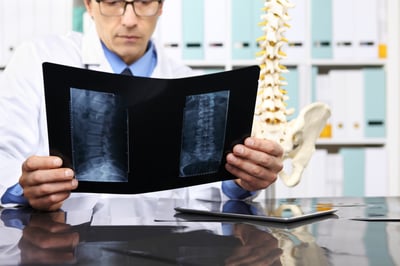If you've recently been advised that your chronic neck pain can be remedied by ACDF surgery, it's time to start preparing for the operation. No surgery should be entered into without first familiarizing yourself with the procedure and educating yourself about how to prepare and what to expect from the outcome. So, let's explore what you need to know, now that this type of surgery has been recommended.
Are There Alternatives to Surgery?
Anterior cervical discectomy and fusion is a common surgical procedure used to treat chronic neck pain caused by a damaged disc. The procedure is usually recommended when nonsurgical interventions have failed. These include:
- Medications—typically NSAIDs (nonsteroidal anti-inflammatory drugs), steroid injections, or narcotic pain relievers
- Physical therapy—typically stretching exercises combined with resting the neck, which can sometimes relieve symptoms
- Hot-cold therapy—alternating heat and ice, which can reduce inflammation and allow the body to heal naturally
- Alternative therapies—frequently massage therapy or acupuncture
If nonsurgical remedies have not alleviated your symptoms, it is time to turn to a surgical option, and ACDF is an effective treatment for a range of chronic neck issues, the most common of which are:
- Degenerated discs, which can occur as we age, as the cervical discs lose fluid, reducing their effectiveness to cushion and support the vertebrae
- Herniated discs, which can place pressure on surrounding nerves, causing numbness, tingling, and pain radiating down the arms
- Arthritis, which can produce bone spurs on the vertebrae, causing many of the same symptoms as with a herniated disc, with accompanied loss of flexibility of the cervical spine
Whichever of these conditions you have, this procedure can alleviate your pain and other symptoms while providing added support to the cervical vertebrae.
 What Exactly Is ACDF?
What Exactly Is ACDF?
Anterior cervical discectomy and fusion is a descriptive title for a procedure that removes a damaged cervical disc through an incision made at the front (anterior) of the neck. The affected cervical joints are then fused together using a bone graft and hardware.
The Procedure
Typically, a one- to two-inch horizontal incision is made into the front of the neck, through the musculature and fibrous tissue, until the disc is accessible. Once the correct disc space has been confirmed, the disc is carefully removed by cutting through the disc's tough outer ring and removing its soft inner core. The fusion is then completed by placing a bone graft in the evacuated disc space, which prevents the bones from collapsing; the graft is then secured by a metal plate affixed to the front of the vertebrae. Eventually, the graft fuses with the vertebrae, created a solid unit of bone, providing support and stability to the affected joint.
What Is the Recovery Process Like for ACDF?
The recovery process will depend on the technique used in the procedure. Some newer procedures are “minimally invasive” (more on that below) and can be done on an outpatient basis. With a traditional procedure, you may have to spend a night in the hospital. Recovery takes place primarily at home, so you will need to arrange to have someone care for you immediately following surgery.
You can expect pain following the procedure—in the neck, where the incision was made, as well as in the hip area, if the bone graft used for disc replacement was taken from your hip. Your pain will be controlled with narcotic pain medications and muscle relaxers, which your doctor will curtail as you recover.
You will likely be placed on a physical therapy regiment that will get you up and moving following surgery, teaching you ways to improve your flexibility and fitness, proper methods of lifting and bending, and how to expedite the healing process.
Why Should I Choose Minimally Invasive Spinal Surgery?
Minimally invasive spine surgery (MISS) achieves all the goals of traditional anterior cervical discectomy and fusion, but with many advantages. Because the surgery is done through a smaller incision and is guided by a powerful microscope through which the surgeon performs the entire procedure, the impact on your body is minimized, and recovery is expedited. The MISS approach provides for:
- Less trauma to the surrounding tissues, since the incision is smaller
- Less blood loss and minimal scarring
- No lengthy hospital stay, since the procedure is performed on an outpatient basis
- Less risk of acquiring hospital-based infections, such as MRSA (methicillin-resistant Staphylococcus aureus)
- Expedited recovery (which means you are up walking sooner)
With all the advantages of the MISS approach, why choose the traditional route? Your next step in approaching ACDF surgery is to ensure you have a qualified surgeon, preferably one experienced in minimally invasive procedures. Confirm that your surgeon is board certified, so that you can rest assured he or she possesses the necessary training in a broad range of spinal disorders. Choose a surgeon who can treat you from start to finish at an integrated facility that offers cutting-edge diagnostics, a state-of-the-art surgical center, soft-tissue and rehabilitative experts to see you through your recovery, and the added option of alternative care (such as acupuncture) to help get you back on your feet and back to an active lifestyle.

About the author
Robert S. Bray, Jr., M.D. Nicknamed “Dr. Fix-It” by The Red Bulletin, Robert S. Bray, Jr., M.D. makes an art of helping the world’s most elite athletes return to push the boundaries of performance. The neurological spine surgeon, recognized globally for his thorough diagnoses and pioneering minimally invasive approach, is quickly redefining sports medicine, one champion at a time. Dr. Bray founded the state-of-the-art, multi-disciplinary DISC Sports & Spine Center (DISC) in 2006 located in Los Angeles, CA. Read more articles by Robert S. Bray, Jr., M.D..





